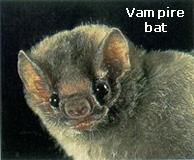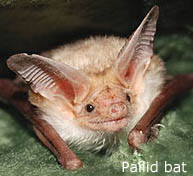yths and Facts
 Bats are not flying mice; they are not even remotely related to rodents. Bats are such unique animals that scientists have placed them in a group all their own, called ‘Chiroptera’, which means hand-wing. Bats are grouped with primates and lemurs in a grand order called Archonta.
Bats are not flying mice; they are not even remotely related to rodents. Bats are such unique animals that scientists have placed them in a group all their own, called ‘Chiroptera’, which means hand-wing. Bats are grouped with primates and lemurs in a grand order called Archonta.
Bats are not blind. Most bats can see as well as humans. Fruit bats have eyesight that is adapted to low-light, much like cats. Fruit bats also see in color.
Bats do not try to become tangled in hair. In fact, insect-eating bats are equipped with a built in sonar system that allows them to navigate at break-neck speed through total darkness. Their unique echolocation ability is literally thousands of times more efficient than any similar system built by humans. If a bat swoops toward you, it’s probably after the mosquito that is hovering just above your head – not your hair.
Bats are not ugly or dirty. Most bats have very cute faces, some even resemble deer, rabbits, and little Chihuahuas. Like cats, bats spend an enormous amount of time grooming their fur, keeping it soft and silky.
 Not all bats are vampires. Of the world’s 1100+ species, only three are vampire bats limited mostly to Latin America. Vampire bats are very small (about the size of a package of M&Ms). Vampire bats do not attack humans or suck our blood; they prefer to get their teaspoon-sized meals from other animals. The remaining 1097 or so species of bats eat insects, fruit, nectar and pollen. A few species eat fish and frogs. Insect-eating bats eat billions of tons of insects each summer. They protect our crops and keep our costs down at the market place. Fruit bats bring us over 450 commercial products and 80 medicines through pollination and seed dispersal. Over 95% of rainforest regrowth comes from seeds that have been spread by fruit bats.
Not all bats are vampires. Of the world’s 1100+ species, only three are vampire bats limited mostly to Latin America. Vampire bats are very small (about the size of a package of M&Ms). Vampire bats do not attack humans or suck our blood; they prefer to get their teaspoon-sized meals from other animals. The remaining 1097 or so species of bats eat insects, fruit, nectar and pollen. A few species eat fish and frogs. Insect-eating bats eat billions of tons of insects each summer. They protect our crops and keep our costs down at the market place. Fruit bats bring us over 450 commercial products and 80 medicines through pollination and seed dispersal. Over 95% of rainforest regrowth comes from seeds that have been spread by fruit bats.
Bats don’t “carry’” rabies, however, they are capable of catching the disease just like any other mammal. Less than one-half of one percent of bats actually contract the disease. In reality, more people die annually from contact with household pets than have died from contact with bats in all recorded history. This doesn’t mean that it’s okay to touch or handle bats, as they may be afraid and bite in self-defense. Bats are wild animals, and all wild animals can be dangerous. Additionally, grounded bats are more likely to be sick so they should never be rescued bare-handed. Please also see our page on bats and rabies.
Bats are shy, gentle, and intelligent. They are among the slowest reproducing animals on earth. Most bat species have only one live young per year. A mother bat nurses her baby from a pair of pectoral breasts. The average life-span of a bat is 25 to 40 years.
Bat populations in rapid decline, and White Nose Syndrome is threatening them even further. Half the bats in the US are listed as rare, threatened or endangered.


No comments:
Post a Comment